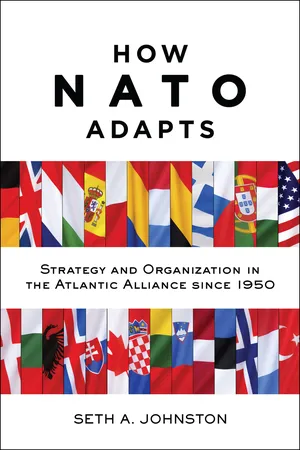
How NATO Adapts
Strategy and Organization in the Atlantic Alliance since 1950
- English
- ePUB (mobile friendly)
- Available on iOS & Android
About this book
Despite momentous change, NATO remains a crucial safeguard of security and peace.
Today's North Atlantic Treaty Organization, with nearly thirty members and a global reach, differs strikingly from the alliance of twelve created in 1949 to "keep the Americans in, the Russians out, and the Germans down." These differences are not simply the result of the Cold War's end, 9/11, or recent twenty-first-century developments but represent a more general pattern of adaptability first seen in the incorporation of Germany as a full member of the alliance in the early 1950s. Unlike other enduring post–World War II institutions that continue to reflect the international politics of their founding era, NATO stands out for the boldness and frequency of its transformations over the past seventy years.
In this compelling book, Seth A. Johnston presents readers with a detailed examination of how NATO adapts. Nearly every aspect of NATO—including its missions, functional scope, size, and membership—is profoundly different than at the organization's founding. Using a theoretical framework of "critical junctures" to explain changes in NATO's organization and strategy throughout its history, Johnston argues that the alliance's own bureaucratic actors played important and often overlooked roles in these adaptations.
Touching on renewed confrontation between Russia and the West, which has reignited the debate about NATO's relevance, as well as a quarter century of post–Cold War rapprochement and more than a decade of expeditionary effort in Afghanistan, How NATO Adapts explores how crises from Ukraine to Syria have again made NATO's capacity for adaptation a defining aspect of European and international security. Students, scholars, and policy practitioners will find this a useful resource for understanding NATO, transatlantic relations, and security in Europe and North America, as well as theories about change in international institutions.
Frequently asked questions
- Essential is ideal for learners and professionals who enjoy exploring a wide range of subjects. Access the Essential Library with 800,000+ trusted titles and best-sellers across business, personal growth, and the humanities. Includes unlimited reading time and Standard Read Aloud voice.
- Complete: Perfect for advanced learners and researchers needing full, unrestricted access. Unlock 1.4M+ books across hundreds of subjects, including academic and specialized titles. The Complete Plan also includes advanced features like Premium Read Aloud and Research Assistant.
Please note we cannot support devices running on iOS 13 and Android 7 or earlier. Learn more about using the app.
Information
Table of contents
- Cover
- Title Page
- Copyright Page
- Dedication
- Contents
- Acknowledgments
- Abbreviations
- 1 Introduction
- Part I: Thinking About Adaptation and Nato
- Part II: Case Studies Of Nato Adaptation
- Part III: Nato Endurance and Implications For The Future
- Notes
- Bibliography
- Index